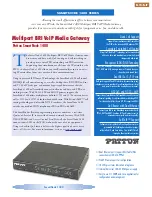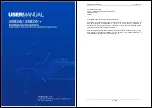
Version 6.6
181
Mediant 3000
User's Manual
13. Media
For V.152 capability, the device supports T.38 as well as VBD codecs (i.e., G.711 A-law
and G.711 μ-law). The selection of capabilities is performed using the coders table (see
'Configuring Coders' on page
When in VBD mode for V.152 implementation, support is negotiated between the device
and the remote endpoint at the establishment of the call. During this time, initial exchange
of call capabilities is exchanged in the outgoing SDP. These capabilities include whether
VBD is supported and associated RTP payload types ('gpmd' SDP attribute), supported
codecs, and packetization periods for all codec payload types ('ptime' SDP attribute). After
this initial negotiation, no Re-INVITE messages are necessary as both endpoints are
synchronized in terms of the other side's capabilities. If negotiation fails (i.e., no match was
achieved for any of the transport capabilities), fallback to existing logic occurs (according to
the parameter IsFaxUsed).
Below is an example of media descriptions of an SDP indicating support for V.152. In the
example, V.152 implementation is supported (using the dynamic payload type 96 and
G.711 u-
law as the VBD codec) as well as the voice codecs G.711 μ-law and G.729.
v=0
o=- 0 0 IN IPV4 <IPAdressA>
s=-
t=0 0
p=+1
c=IN IP4 <IPAddressA
m=audio <udpPort A> RTP/AVP 18 0
a=ptime:10
a=rtpmap:96 PCMU/8000
a=gpmd: 96 vbd=yes
Instead of using VBD transport mode, the V.152 implementation can use alternative relay
fax transport methods (e.g., fax relay over IP using T.38). The preferred V.152 transport
method is indicated by the SDP ‘pmft’ attribute. Omission of this attribute in the SDP
content means that VBD mode is the preferred transport mechanism for voice-band data.
To configure T.38 mode, use the CodersGroup parameter.
Note:
You can also configure the device to handle G.711 coders received in INVITE
SDP offers as VBD coders, using the HandleG711asVBD parameter. For
example, if the device is configured with G.729 and G.711 VBD coders and it
receives an INVITE with an SDP offer containing G.729 and “regular” G.711
coders, it sends an SDP answer containing G.729 and G.711 VBD coders,
allowing subsequent bypass (passthrough) sessions if fax / modem signals
are detected during the call.
13.2.7 Fax Transmission behind NAT
The device supports transmission from fax machines (connected to the device) located
inside (behind) a Network Address Translation (NAT). Generally, the firewall blocks T.38
(and other) packets received from the WAN, unless the device behind the NAT sends at
least one IP packet from the LAN to the WAN through the firewall. If the firewall blocks T.38
packets sent from the termination IP fax, the fax fails.
To overcome this, the device sends No-Op (“no-signal”) packets to open a pinhole in the
NAT for the answering fax machine. The originating fax does not wait for an answer, but
immediately starts sending T.38 packets to the terminating fax machine upon receipt of a
re-INVITE with T.38 only in the SDP, or T.38 and audio media in the SDP. This feature is
configured using the T38FaxSessionImmediateStart parameter. The No-Op packets are
enabled using the NoOpEnable and NoOpInterval parameters.
Summary of Contents for Mediant 3000
Page 2: ......
Page 26: ...User s Manual 26 Document LTRT 89729 Mediant 3000 Reader s Note...
Page 27: ...Part I Getting Started with Initial Connectivity...
Page 28: ......
Page 40: ...User s Manual 40 Document LTRT 89729 Mediant 3000 Reader s Notes...
Page 41: ...Part II Management Tools...
Page 42: ......
Page 44: ...User s Manual 44 Document LTRT 89729 Mediant 3000 Reader s Notes...
Page 80: ...User s Manual 80 Document LTRT 89729 Mediant 3000 Reader s Notes...
Page 98: ...User s Manual 98 Document LTRT 89729 Mediant 3000 Reader s Notes...
Page 103: ...Part III General System Settings...
Page 104: ......
Page 113: ...Part IV General VoIP Configuration...
Page 114: ......
Page 144: ...User s Manual 144 Document LTRT 89729 Mediant 3000 Reader s Notes...
Page 164: ...User s Manual 164 Document LTRT 89729 Mediant 3000 Reader s Notes...
Page 222: ...User s Manual 222 Document LTRT 89729 Mediant 3000 Reader s Notes...
Page 224: ...User s Manual 224 Document LTRT 89729 Mediant 3000 Reader s Notes...
Page 275: ...Part V Gateway and IP to IP Application...
Page 276: ......
Page 278: ...User s Manual 278 Document LTRT 89729 Mediant 3000 Reader s Notes...
Page 399: ...Part VI Session Border Controller Application...
Page 400: ......
Page 402: ...User s Manual 402 Document LTRT 89729 Mediant 3000 Reader s Notes...
Page 464: ...User s Manual 464 Document LTRT 89729 Mediant 3000 Reader s Notes...
Page 465: ...Part VII Stand Alone Survivability Application...
Page 466: ......
Page 474: ...User s Manual 474 Document LTRT 89729 Mediant 3000 Reader s Notes...
Page 494: ...User s Manual 494 Document LTRT 89729 Mediant 3000 Reader s Notes...
Page 497: ...Part VIII IP Media Capabilities...
Page 498: ......
Page 501: ...Part IX High Availability System...
Page 502: ......
Page 515: ...Part X Maintenance...
Page 516: ......
Page 522: ...User s Manual 522 Document LTRT 89729 Mediant 3000 Reader s Notes...
Page 524: ...User s Manual 524 Document LTRT 89729 Mediant 3000 Reader s Notes...
Page 552: ...User s Manual 552 Document LTRT 89729 Mediant 3000 Reader s Notes...
Page 562: ...User s Manual 562 Document LTRT 89729 Mediant 3000 Reader s Notes...
Page 565: ...Part XI Status Performance Monitoring and Reporting...
Page 566: ......
Page 578: ...User s Manual 578 Document LTRT 89729 Mediant 3000 Reader s Notes...
Page 609: ...Part XII Diagnostics...
Page 610: ......
Page 624: ...User s Manual 624 Document LTRT 89729 Mediant 3000 Reader s Notes...
Page 626: ...User s Manual 626 Document LTRT 89729 Mediant 3000 Reader s Notes...
Page 638: ...User s Manual 638 Document LTRT 89729 Mediant 3000 Reader s Notes...
Page 639: ...Part XIII Appendix...
Page 640: ......
Page 864: ...User s Manual 864 Document LTRT 89729 Mediant 3000 Reader s Notes...
Page 871: ...Version 6 6 871 Mediant 3000 User s Manual 55 Selected Technical Specifications Reader s Notes...
















































